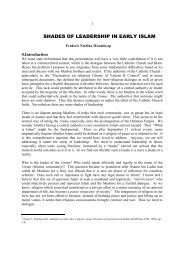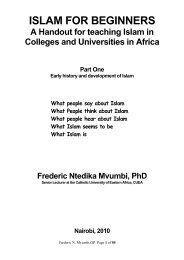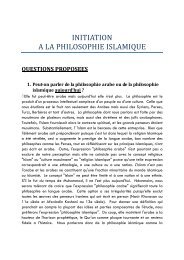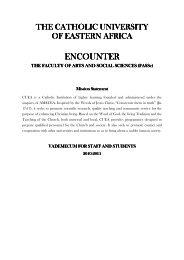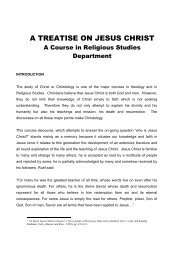INTRODUCTION TO ISLAMIC THEOLOGY.pdf - CUEA
INTRODUCTION TO ISLAMIC THEOLOGY.pdf - CUEA
INTRODUCTION TO ISLAMIC THEOLOGY.pdf - CUEA
Create successful ePaper yourself
Turn your PDF publications into a flip-book with our unique Google optimized e-Paper software.
37Egypt and moved the capital from Mahdiyya on the Tunisian coast to the new city of Cairo. TheFâtimids sent agents to preach in `Abbâsid lands and came close to winning these lands to theircause. But the movement had already peaked with the conquest of Egypt and dwindled as a worldpolitical force thereafter. Sunnite theologians, however, came to grips with Fâtimid arguments onlyin the 11th century. Ismâ`îlism still survives in Bombay and central India and in scatteredcommunities in the Middle East; it is also followed by Indian Muslims in Kenya. The current leaderis Agha Khan, who lives in Paris.The name Imâmism came into use only around the year 900, although Imâmites claimed earlierorigins in the Râfidites and others before them to lend legitimacy to their movement. Imâmites differfrom Ismâ`îlites mainly in their adherence to Mûsâ al-Kâzim (d. 799) as the 7th imâm rather thanhis brother Ismâ`îl. Furthermore, while the Ismâ`îlites held that the successors if Ismâ`îl werehidden and unknown except to their chosen agents, the Imâmites held that the series of imâmscontinued publicly until the 12th imâm, Muhammad son of Hasan al-`Askarî ibn-`Alî. The latter, the11th imâm, died in 874, and his son Muhammad is alleged to have disappeared miraculously in878. Thereafter the Imâmites have maintained allegiance to a series of hidden imâms. Thelegitimacy of this line they say derives from the designation which Muhammad the Prophet made to`Alî, and he and each imâm thereafter made to his successor. The Imâmites’ allegiance to theirown imâm did not mean that they planned a coup against the `Abbâsids. First of all, by this timethe `Abbâsid caliphs had lost most of their power anyway, and their position was not coveted;secondly the acceptance of a hidden imâm excused them, like the Râfidites before, from activepolitical involvement. Today Imâmite Shî`ites dominate Iran, where they became politicallyprominent in the 16th century.Like the Ismâ`îlites, the Imâmites regard Abû-Bakr, 'Umar and 'Uthmân as usurpers and theCompanions who supported them as partners in crime. They therefore repudiate the Sunnitecollections of Hadîth which include these men in the isnâds and accept instead the collection of al-Kulînî (d. 939). This contains over 15,000 Hadîths, with the name of the imâm in the isnâd of eachHadîth. The name of the imâm, according to the Imâmites, is what guarantees the Hadîth’sauthenticity, since he is an infallible teacher. This difference regarding the fundamentals ofreligions set Shî`ites far apart from Sunnite Muslims and at the same time stimulated the Sunnitesto a greater awareness of their own identity.The basic principles of Shî`ism, as it matured, are: 1) that the imâm must be a descendant ofMuhammad through `Alî and Fâtima; 2) that the imâm is immune from sin and error, so that hisinterpretation of the Qur’ân and his commands must be followed; 3) the imâm gets his authority byappointment from his predecessor, not by election; 4) the imâm has long ago gone into hiding, butsometimes acts through a representative who, in popular opinion, has the same authority; 5) jihâdto establish the rule of the imâm is necessary only when the imâm or his representative appearsand calls for action; 6) the martyrdom of `Alî and Husayn show the way to salvation, and everyShî`ite should be happy to shed his blood in the same way.SunnismAs in the case of Shî`ism, Muslim writers since the 10th century have presented a picture of a fullyformed Sunnism going right back to Muhammad. The assumption in both cases is that Islamic




